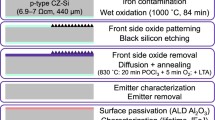Abstract
The recombination lifetime and diffusion length of intentionally iron-contaminated samples were measured by the Surface Photo Voltage (SPV) and the Elymat technique. The lifetime results from these techniques for intentionally iron-contaminated samples were analysed, in particular for the aspect of the injection-level dependency of recombination lifetime. Based on theoretical considerations, a method for the analysis of deep-level parameters combining constant photon flux SPV and Elymat measurements has been developed. This method is based on a detailed numerical analysis of the Elymat technique, including the Dember electric field, the characteristics of the laser beam, the transport parameters of the semiconductor and multilevel Shockley-Read-Hall (SRH) recombination kinetics. The results of the numerical simulation are applied to the analysis of recombination lifetime measurements on intentionally iron-contaminated samples. We compared numerical simulations and experimental results from SPV and Elymat for p-type samples using the classical acceptor level atE v +0.1 eV and the donor level of FeB pairs atE c -0.3 eV as recombination centre. Better consistency in the interpretation of the results has been found in the doping range 1014–1016 cm−3 supposing theE c -0.3 eV level as predominant recombination centre. An attempt to extract the electron and hole capture cross-sections for this defect is made.
Similar content being viewed by others
References
G. Zoth, W. Bergholz: J. Appl. Phys.67, 6764 (1990)
L. Jastrzebski, W. Henley, C.J. Nuese: Solid State Technol.35, 27 (1992)
W.B. Henley, L. Jastrzebski, N.F. Haddad: Proc. Electrochem. Soc.93-2, 476 (1993)
W.H. Rieger:Proc. Millipore Symp., Munich (1990)
F. Shimura, T. Okui, T. Kusama: J. Appl. Phys.67, 7168 (1990)
G. Ferenczi, T. Pavelka, P. Tütto, L. Köster: Solid State Phenom.32-33, 609 (1993)
C.T. Sah, R.N. Noyce, W. Shockley: IRE Proc.1228 (1957)
K. Graff, H. Pieper: J. Electrochem. Soc.128, 669 (1981)
S.D. Brotherton, P. Bradley, A. Gill: J. Appl. Phys.57, 1941 (1985)
H. Nakashima, T. Sadoh: Proc. Mater. Res. Soc.262, 555 (1992)
S. Ghatnekar-Nilsson, M. Klevermann, P. Emanunuelsson, H.G. Grimmeis: Semicond. Sci. Technol.8, 1857 (1993)
W. Gehlhoff, K. Irmscher: Solid State Phenom.32-33, 219 (1993)
Y. Hayamazu, T. Hamaguchi, S. Ushio, T. Abe: J. Appl. Phys.69, 3077 (1991)
A.M. Goodman: J. Appl. Phys.32, 2550 (1961)
V. Lehmann, H. Föll: J. Electrochem. Soc.135, 2831 (1988)
S.M. Sze:Physics of Semiconductor Devices (Wiley Interscience, New York 1981) p. 87
W. Shockley, W.T. Read: Phys. Rev.87, 835 (1952)
R.N. Hall: Phys. Rev.83, 228 (1951)
W. Shockley, J.T. Last: Phys. Rev.107, 392 (1957)
C.T. Sah, W. Shockley: Phys. Rev.109, 1103 (1958)
W. Wijaranakula: J. Electrochem. Soc.140, 275 (1993)
H. Nakashima, T. Isobe, Y. Yamamoto, K. Hashimoto: Jpn. J. Appl. Phys.27, 1542 (1988)
K. Ryoo, W.E. Socha: J. Electrochem. Soc.138, 1424 (1991)
D. Walz, G. Le Carval, J.-P. Joly, G. Kamarinos: Semicond. Sci. Technol.10, 1022–33 (1995)
Silvaco Users Manual, release 2 (Silvaco International, Santa Clara, CO 1993)
D.K. Schroder:Semiconductor Materials and Device Characterization (Wiley Interscience, New York 1990) pp. 424–431
M. Hourai, T. Naridomi, Y. Oka, K. Murakami, S. Sumita, N. Fujino, T. Shiraiwa: Jpn. J. Appl. Phys.27, L2361 (1988)
L. Mouche: Etude des mécanismes de contamination particulaire et métallique, des substrats de silicium en solution; Dissertation, Marseille (1994)
J. Crank:Mathematics of Diffusion (Clarendon, Oxford 1957) pp. 42–61
D. Walz: Caractérisation de la contamination metallique dans le Silicium par des méthodes de duréé de vie; application au cas du fer daps le Silicium de type P. Dissertation thesis, Grenoble (1995)
W. Bergholz, D. Landsmann, B. Schauberger, B. Schoepperl: Proc. Electrochem. Soc.93-15 (1993)
D. Walz, J.P. Joly, R. Falster, G. Kamarinos: Jpn. J. Appl. Phys.34, 4091 (1995)
S.W. Glunz, A.B. Sproul, W. Warta, W. Wettling: J. Appl. Phys.75, 1611 (1994)
J.M. Dorkel, Ph. Lecture: Solid-State Electron.24, 821 (1981)
K.A. Adilov: Phys. Stat. Sol. (b)167, 159 (1991)



